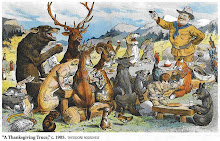Deer Population Size ; Vermont Fish & Wildlife(January 2012 Report)
The VFWD estimates the pre-hunt size of the deer population using a variety of methods and
sources of data that include buck harvest, hunter effort, deer sighting rates by hunters, and
roadkills. Such estimates are available back to 2000 when Vermont’s hunter effort surveys
began. To estimate total population size, the buck:doe and fawn:doe ratios must also be
estimated. The buck:doe ratio is derived from age data (see pages 8-9 below), and the fawn:doe
ratio is estimated from reproductive data collected in Vermont and fawn survival data from
published scientific research.
whitetail deer
.
The hard winter conditions of 2001 and 2003 had an impact on Vermont’s deer herd, but
subsequent mild winters, particular in 2006, and reduced antlerless deer harvests allowed rapid
recovery through 2007 .
eastern coyote
Since then, Vermont has experienced more severe than average winters in four of the past five years. The winter of 2011 was particularly severe in southern and western Vermont. The deer population estimate entering the 2011 deer seasons was 123,000, + 15,000 animals, a figure within the range of the population objectives asset forth in the deer management plan.
---------------------------------------------------------------------------------------------
Burlington FreePress reports a very successful deer hunting season in Vermont in 2012
MONTPELIER — The state Fish and Wildlife Department says Vermont deer hunters successfully killed nearly 14,000 deer in 2012, a 14 percent increase over the previous year.
The totals reflect archery, youth, rifle and muzzleloader seasons.
Officials say last winter's relatively mild weather and shallow snow depths likely contributed to this fall's elevated deer harvest.
The low availability of traditional food sources such as apple orchards and beech and oak stands this past summer and fall also resulted in deer changing movement patterns.
The department says one of the biggest increases was in archery, which rose 25 percent, to 3,384 deer.
Hunters killed 6,300 deer during rifle season, an increase of 9 percent over last year's rifle total of 5,759 deer.
-----------------------------------------------------------------------------------------
Vermont deer herd healthy
vtdigger.com
So hunters are the only realistic deer population control mechanism, and the only effective population control technique is to kill more female deer.Neither hunters nor F&W officials put it that bluntly, but that’s what it amounts to.
Fisher
“We have been aggressive in issuing more doe permits,” said Scott, which is just another way of saying the Department wants more female deer to be shot.
Years ago, shooting “antlerless” deer was unthinkable in Vermont.
There are still hunters in the state who find it unseemly if not unmanly to shoot a doe. It may be a Vermont peculiarity. Scott said hunters in Maine have been happily shooting does for decades.
Unless the females are killed, though, the herd would get too big, Scott said. Deer, he said, will over-reproduce. That’s what happened in the 1960s when the herd was huge, about 240,000 deer. But many of them were malnourished and feeble. Perhaps ironically, it seems that the most humane approach to Vermont’s deer herd is to hold down its population by shooting enough of its potential mothers.
black bear
In other words, despite what some hunters say, the herd is not too small. If it were bigger, it would be less healthy. Today’s population is much better for the deer herd than the overpopulation of the 60s. It’s also better for woodland owners who don’t want their trees destroyed by all that browsing.














No comments:
Post a Comment